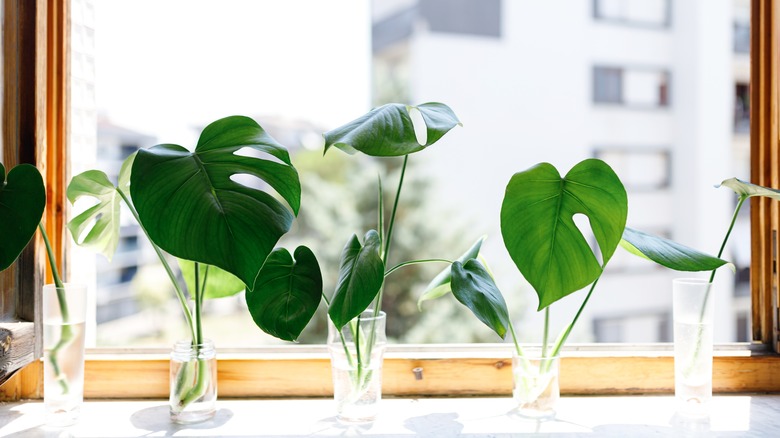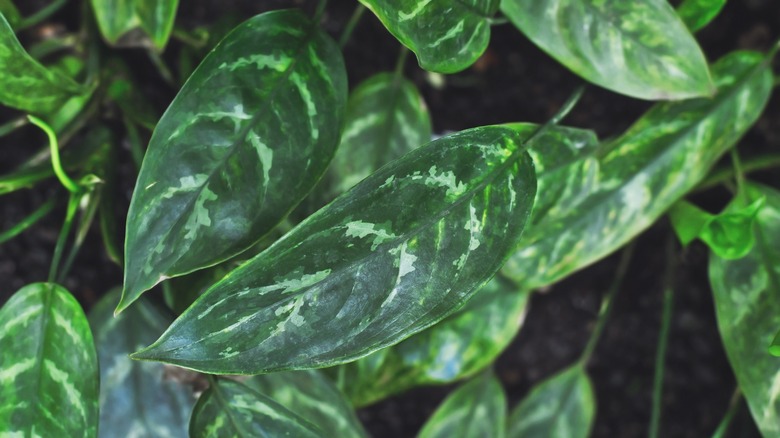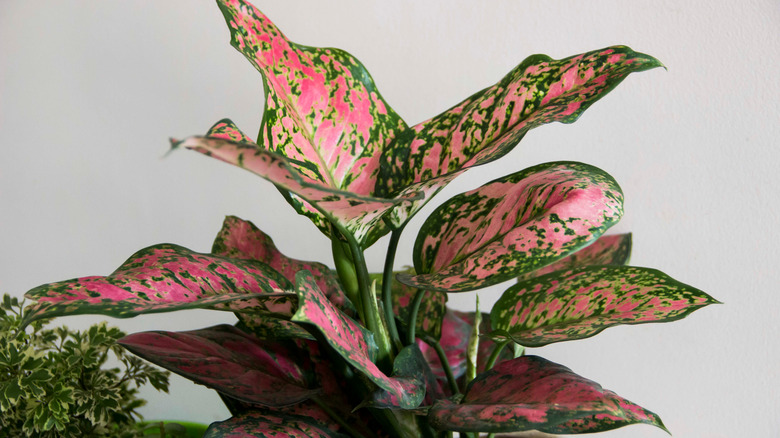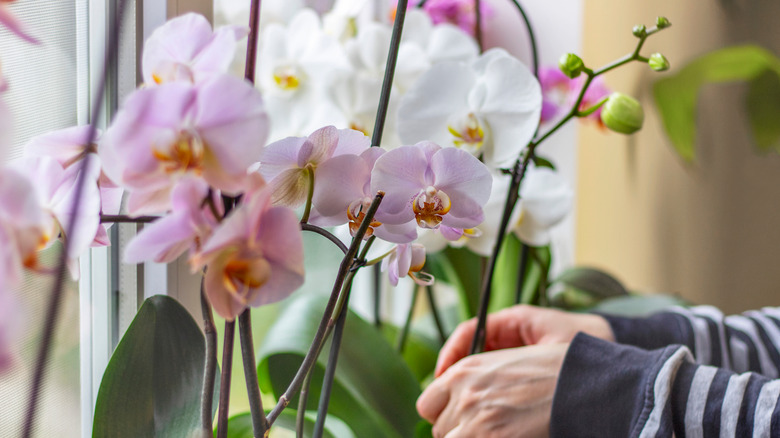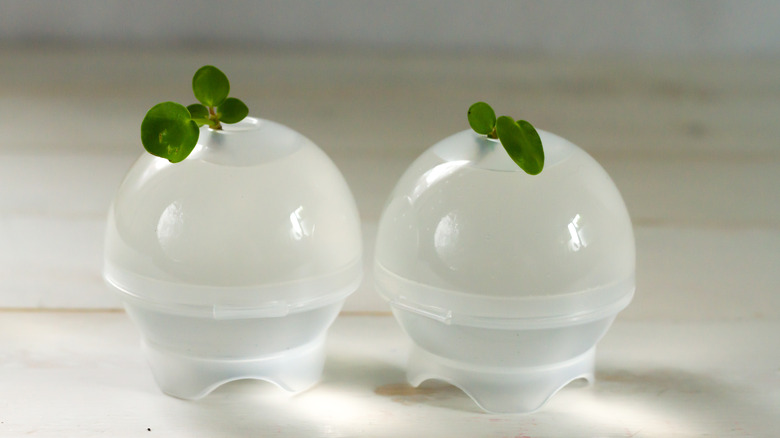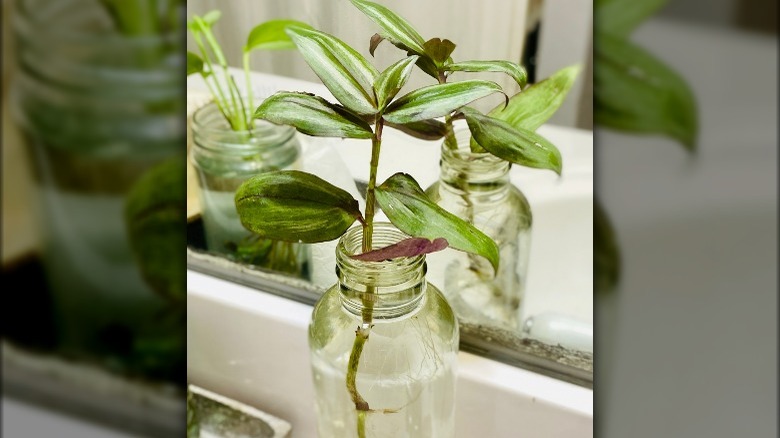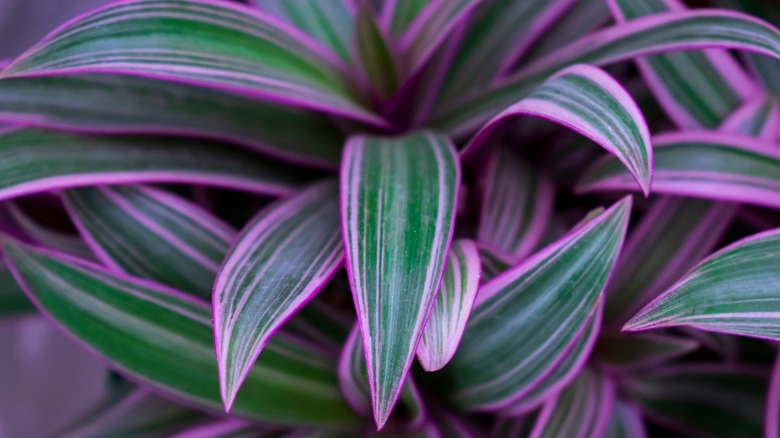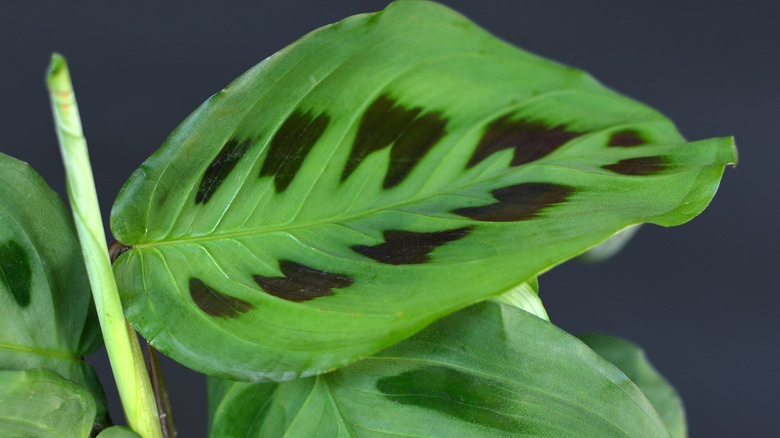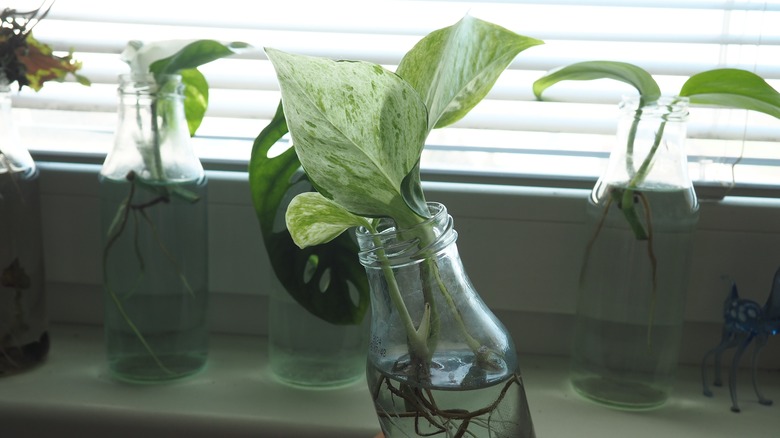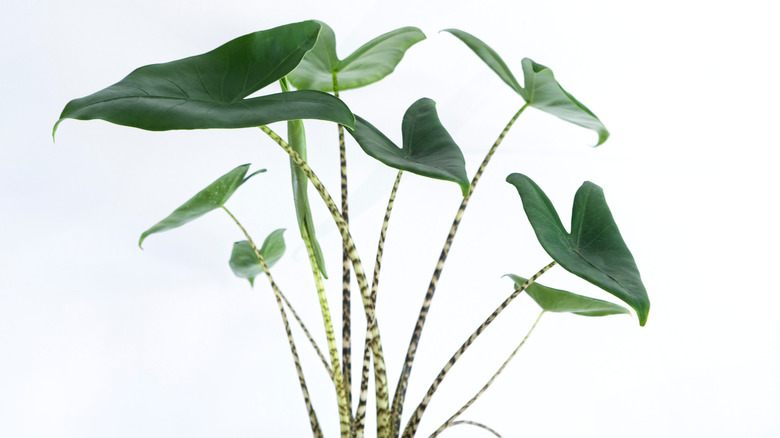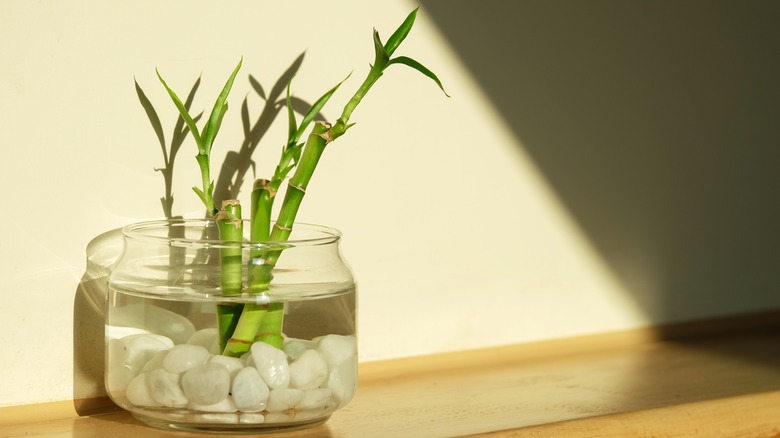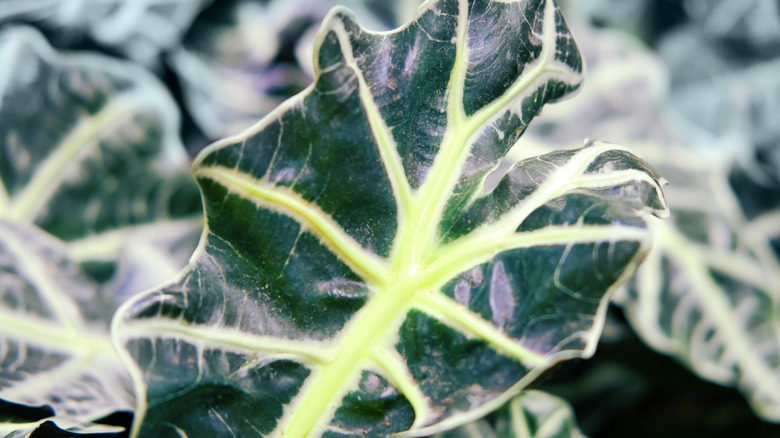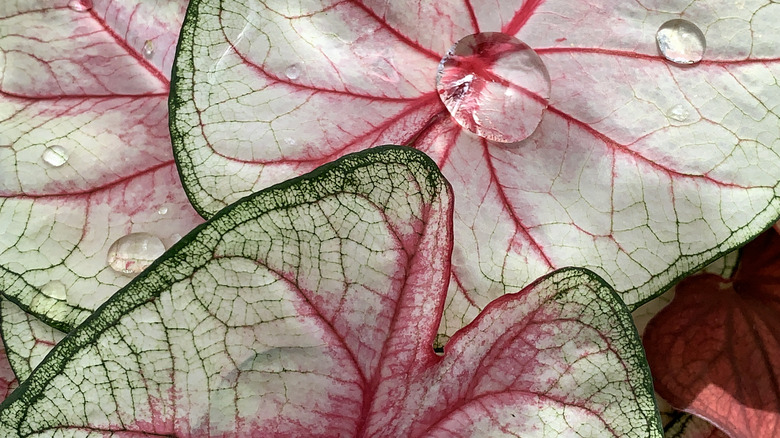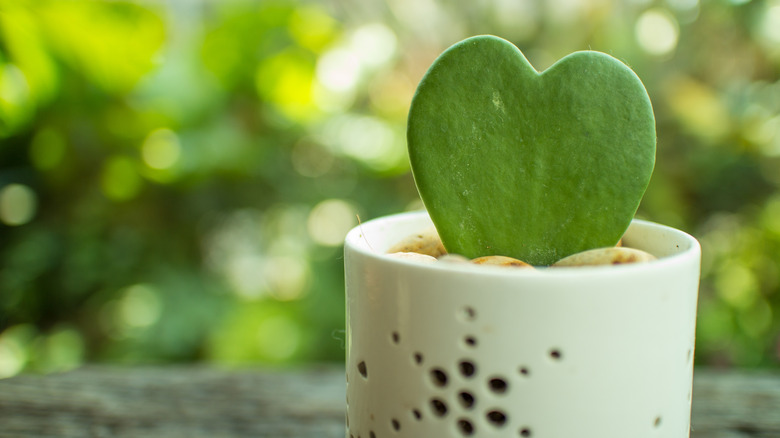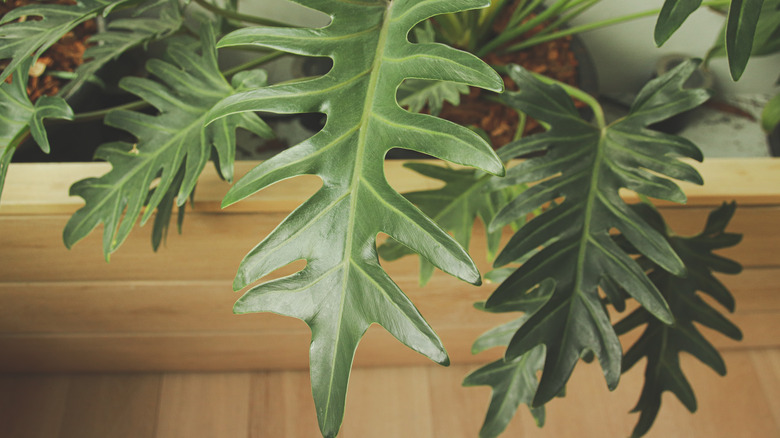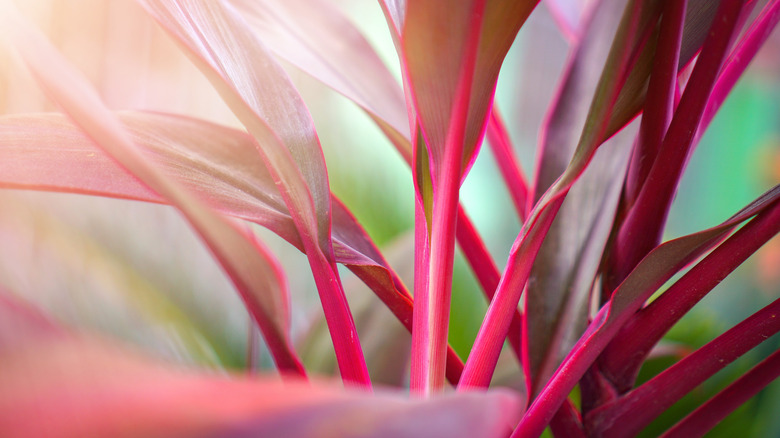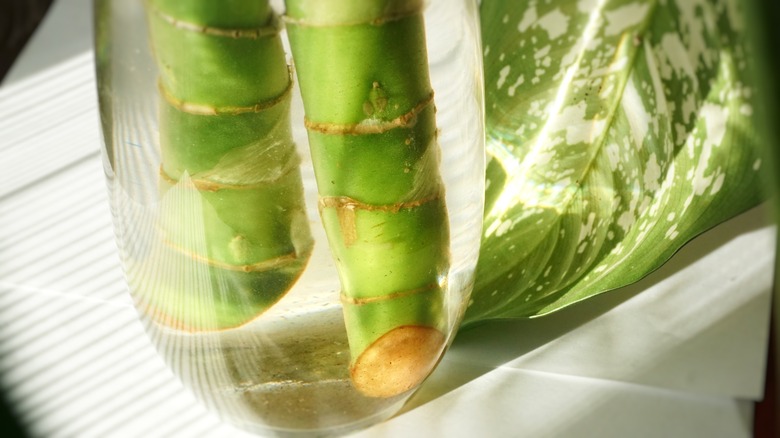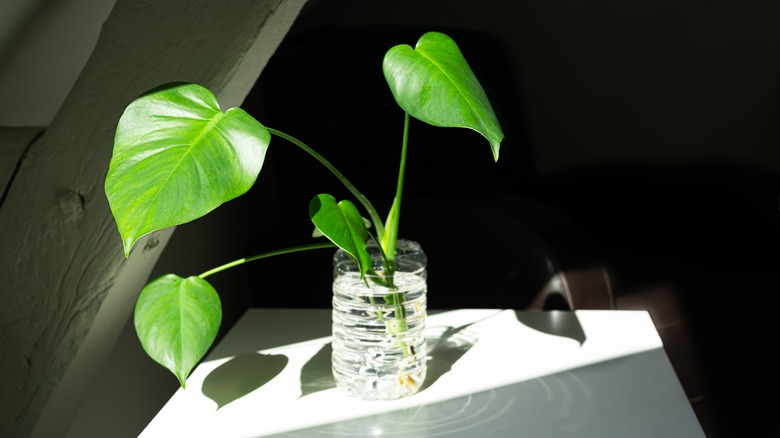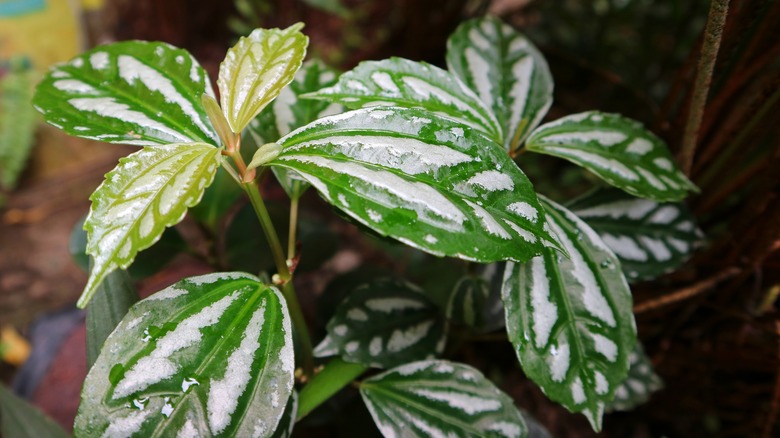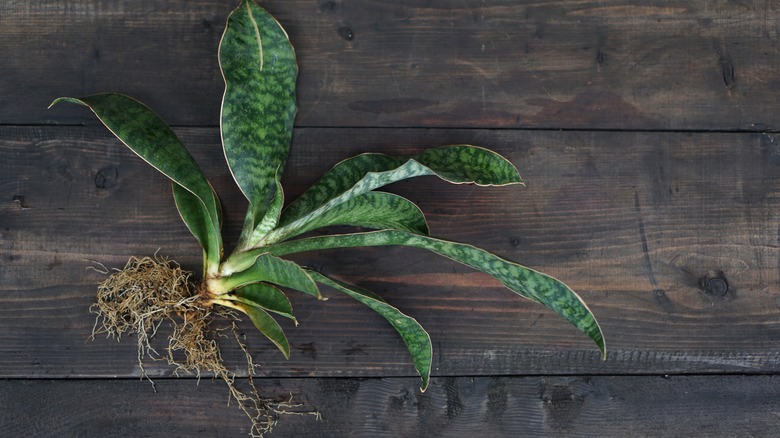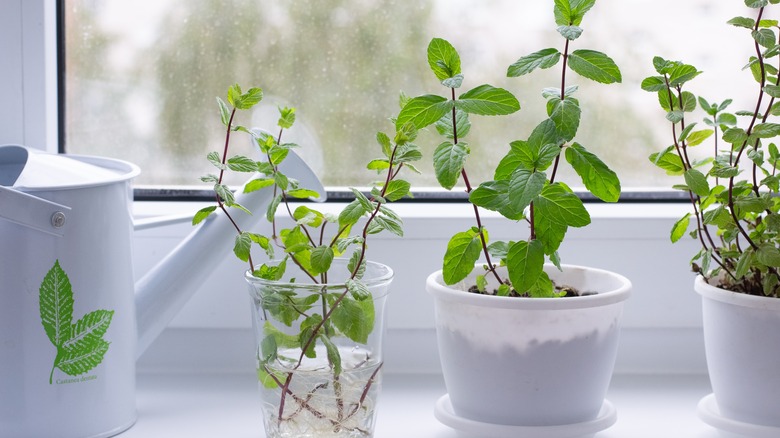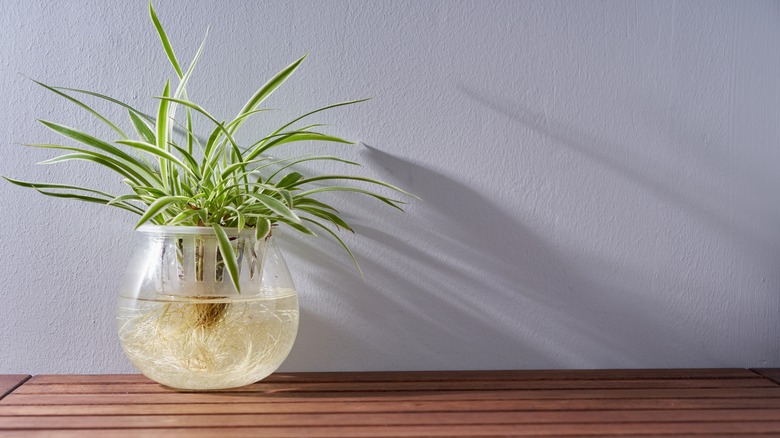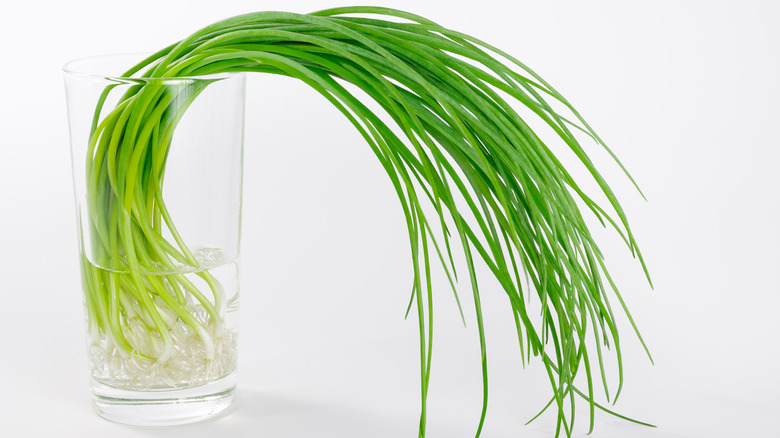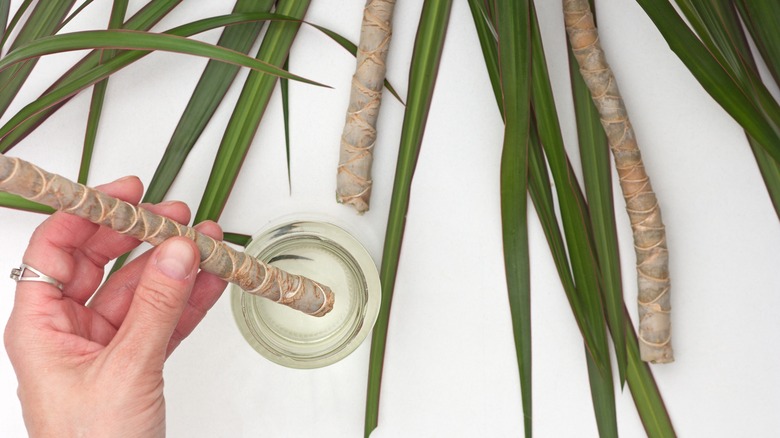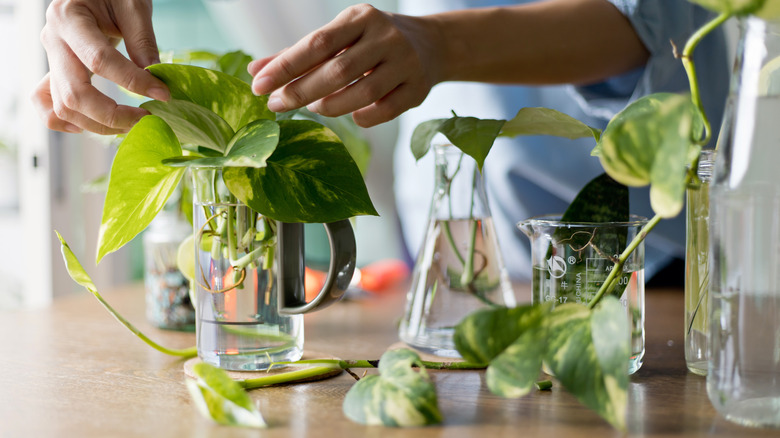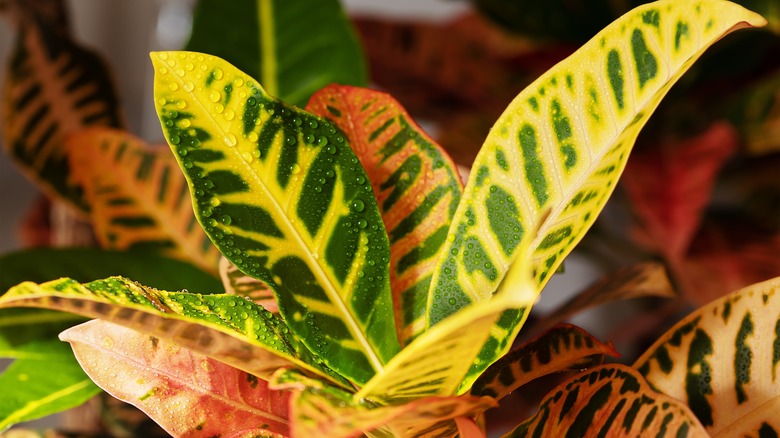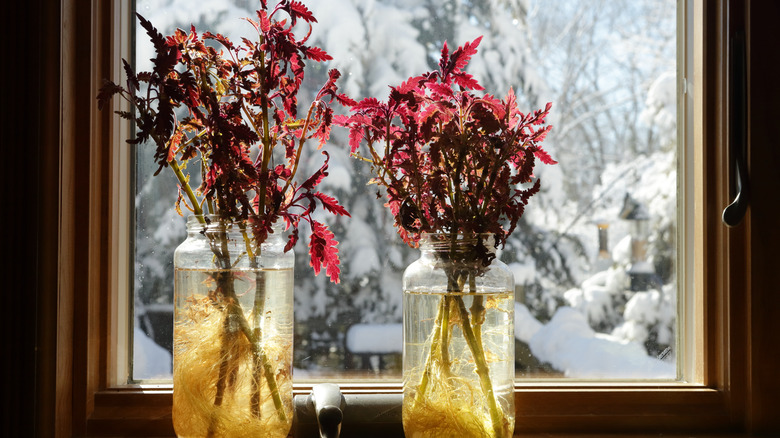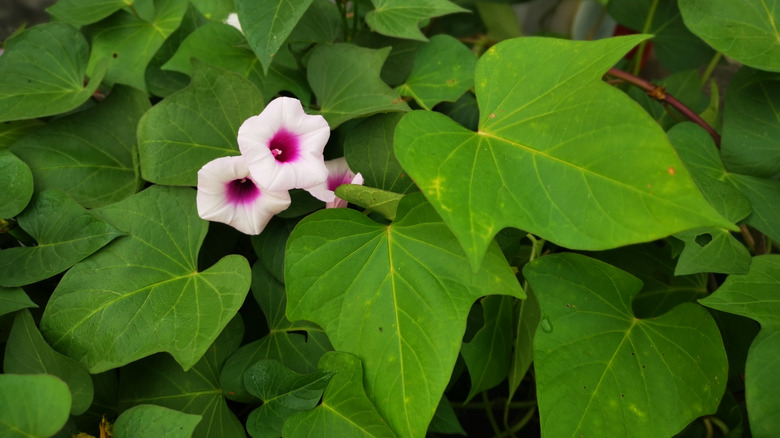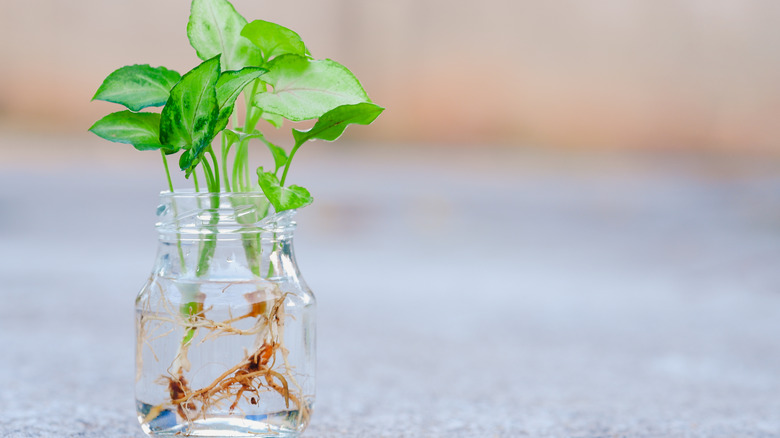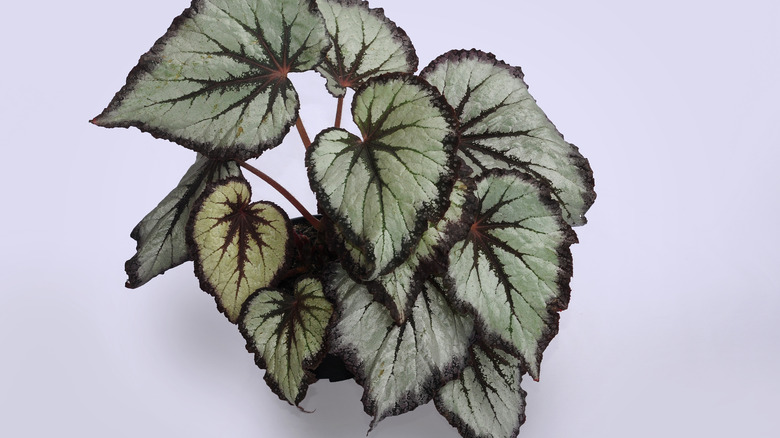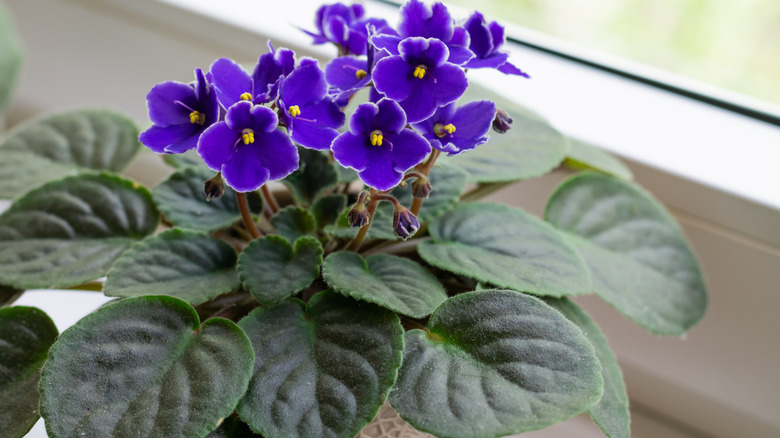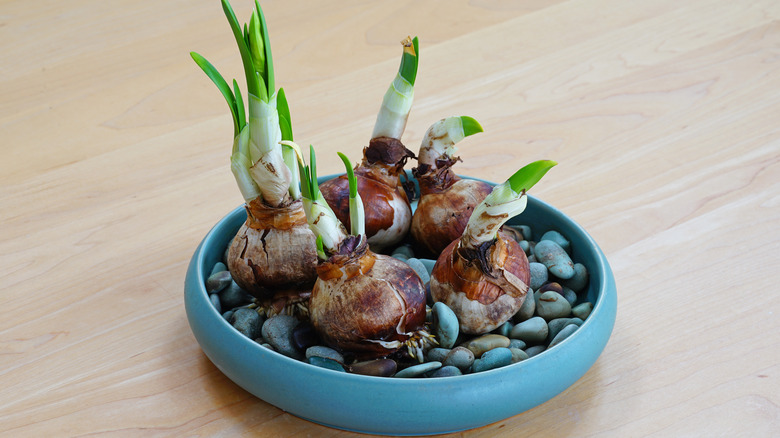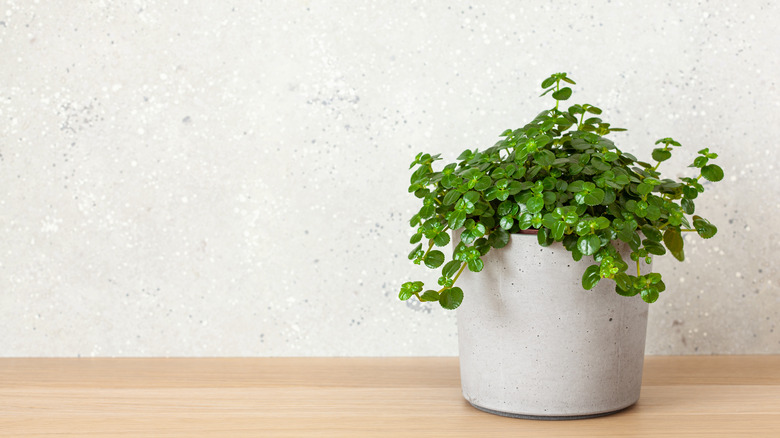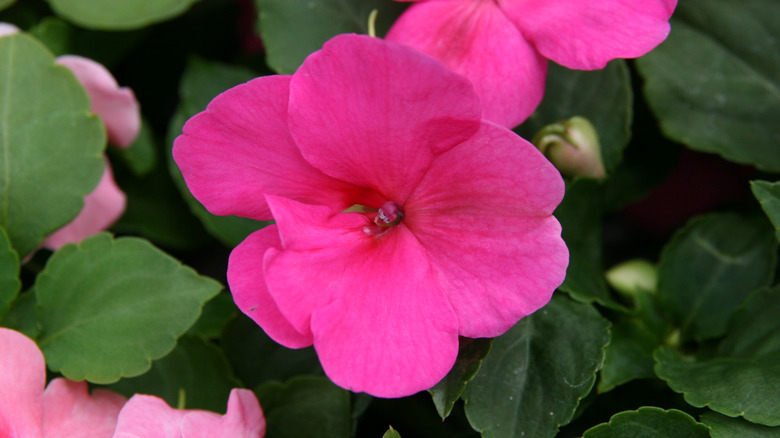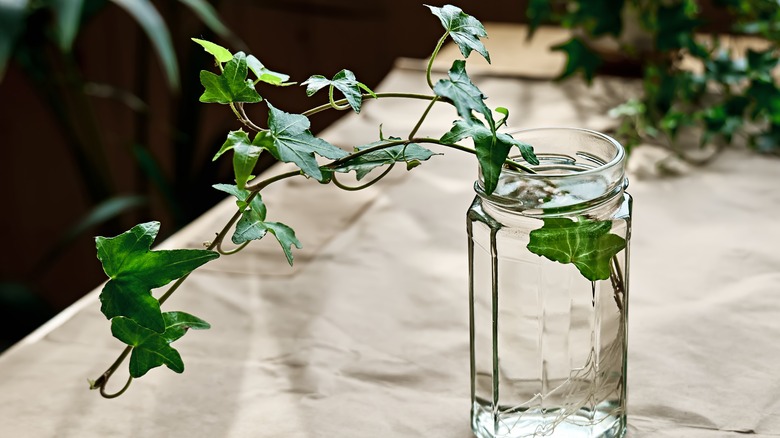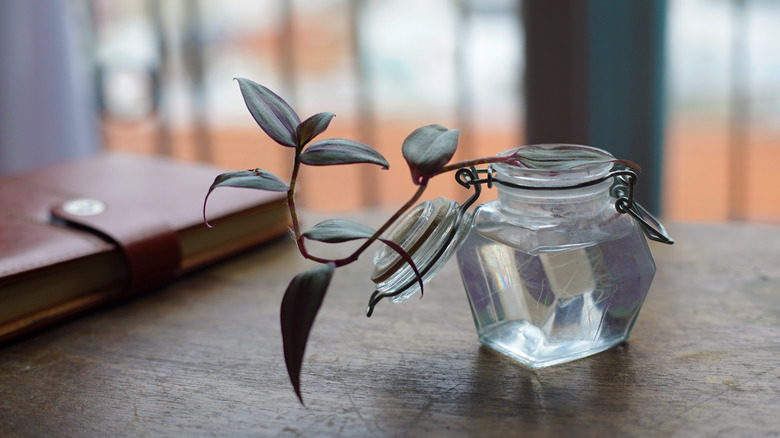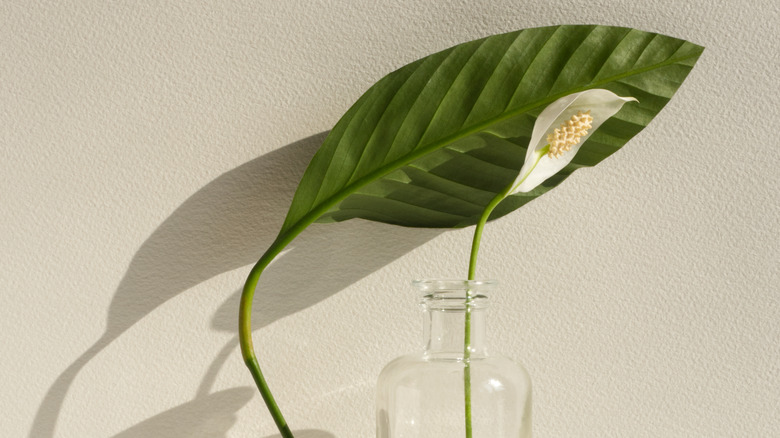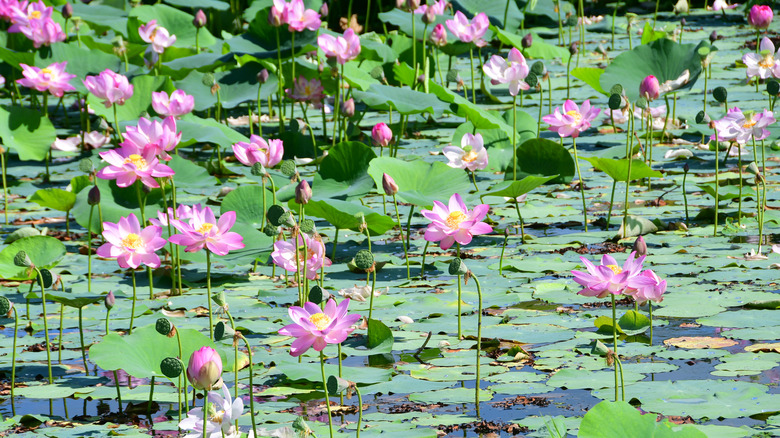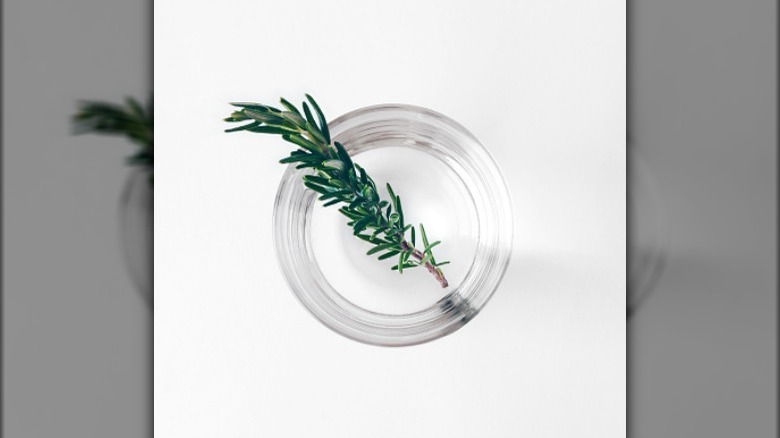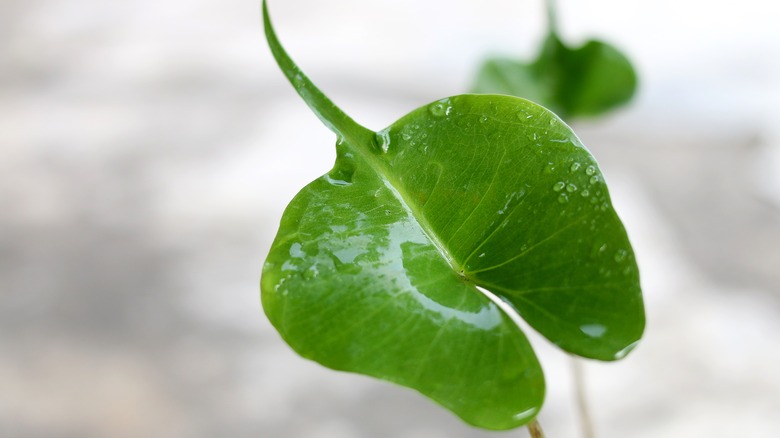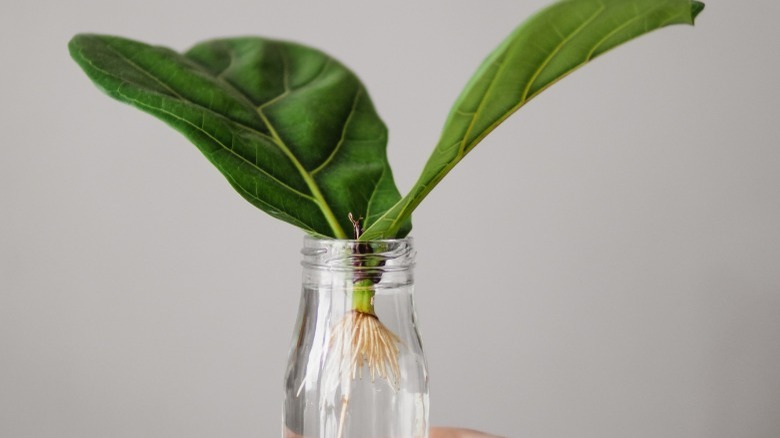40 Indoor Plants That Can Grow In Water Indefinitely
Soil, though it is necessary for many plants, can cause a lot of problems. Many of the health issues that plants face start in the soil. It can retain too much moisture or too little, harbor bacteria, attract pests, or hide root problems that cause an array of deadly diseases and other complications. If you're looking to stay away from these frustrating obstacles, many beautiful houseplants can grow without soil.
If you've had any experience with propagation from cuttings, you know that most houseplants can grow new roots in just a few weeks by placing their cut stems in a glass of water. However, it may come as a surprise that a lot of these cuttings can stay in the water indefinitely as long as you know how to care for them in this way. Oklahoma State University Extension teaches us about the method known as hydroponics, saying, "There is no physiological difference between plants grown hydroponically and those grown in soil ... In hydroponics, the plant roots are moistened with a nutrient solution containing [inorganic] elements. The subsequent processes of mineral uptake by the plant are the same." They also note, "Home hydroponic gardens have become so simple that people without a green thumb can be successful in growing flowers and vegetables in their homes." Check out this guide containing 40 different plants that can form roots in water and be kept alive for a long time with some hydroponic nutrients.
1. Philippine evergreen
The Philippine evergreen plant (Aglaonema commutatum), also known as the Chinese evergreen, is an herbaceous perennial native to the Philippines and northeastern Celebes, as told by North Carolina State Extension. Planted in a container, this plant prefers its soil to be consistently moist; however, its roots can be submerged entirely in water with no soil, and it will continue to grow this way for a very long time.
Sunlight Needs: Low or medium light
Water Needs: Lower stems submerged in water
Bloom Season: Summer and fall
Size: 1 to 2 feet tall
2. Chinese evergreen
Also called Chinese evergreens (Aglaonema modestum), this aglaonema species is similar to the Philippine evergreen plant, but it can be distinguished by its darker green foliage and ability to withstand low light conditions better than its sibling. As warned by North Carolina State Extension, this leafy plant's foliage is very poisonous, especially to cats, dogs, and horses, due to its calcium oxalate crystals.
Sunlight Needs: Medium to low indirect light
Water Needs: Lower stems submerged in water
Bloom Season: Summer
Size: 1 to 3 feet tall and 2 to 4 feet wide
3. Moth orchid
Moth orchids (Phalaenopsis spp.) have a strange growth habit. University of Maryland Extension explains that they send out aerial roots that grow above their container. These roots commonly crawl along surfaces near its pot. Do not attempt to cut them off; this is perfectly normal. This growth habit allows you to grow flowers without soil. Simply provide their roots with some water and watch them thrive.
Sunlight Needs: Bright indirect light
Water Needs: Water tray with pebbles for the aerial root system
Bloom Season: Winter to spring (via Missouri Botanical Garden)
Size: Up to 3 feet tall
4. Chinese money plant
The Chinese money plant (Pilea peperomioides) is a unique Asian plant with circular green leaves on thin stems. Like money trees and lucky bamboo, the Chinese money plant is thought to bring its owners luck and good fortune, as mentioned by Logee's. You do not want to kill this plant by accident; one way to grow it successfully is to keep its cuttings in water.
Sunlight Needs: Bright to medium indirect light
Water Needs: Container of water with coarse substrate
Bloom Season: Winter to spring
Size: 8 to 12 inches tall
5. Inch plant
The inch plant (Tradescantia zebrina), which is also known as the zebra plant, is loved for its dark purple, green, and white leaves, which can be variegated in multiple different ways. The Wisconsin Horticulture Division of Extension describes the inch plant as an adaptable little plant that you'll find difficult to kill, even if you have limited experience with plants. It's known to grow somewhat leggy indoors, but these stems can be easily removed and propagated in water.
Sunlight Needs: Bright indirect light
Water Needs: Lower stems submerged in water
Size: 6 to 12 inches tall
6. Boat lily
Boat lilies (Tradescantia spathacea) are herbaceous perennials native to Guatemala, Belize, and Southern Mexico. As illustrated by Missouri Botanical Garden, they have brightly colored purple and green foliage and small white flowers protected by purple bracts. The plant is loved for its easy-to-grow nature and tolerance to adverse growing conditions. This may be why gardeners enjoy adding the boat lily to their hydroponic plant collection.
Sunlight Needs: Bright indirect light
Water Needs: Container of water with coarse substrate
Bloom Season: Blooms throughout the year
Size: 6 to 12 inches tall
7. Prayer plant
The prayer plant (Maranta leuconeura), which is native to the rain forests of Brazil, enjoys high humidity, warm temperatures, and nutrient-rich soil, as expressed by Missouri Botanical Garden. Without nutrient-rich soil, they can grow in water, but they will need to be fertilized with hydroponic nutrients. Indoors, keep your prayer plant away from direct sunlight, as its leaves may lose some color when exposed.
Sunlight Needs: Medium indirect light
Water Needs: Lower stems submerged in water
Bloom Season: Spring to summer
Size: 6 to 12 inches tall and wide
8. Heartleaf philodendron
The heartleaf philodendron (Philodendron hederaceum) is an extremely adaptable plant that will grow happily in the water. If you are new to the propagation and growing of plants in nothing but water, the heartleaf philodendron is a good place to start. As warned by the University of Florida, don't grow it too near a bright window that receives direct sunlight, as this will likely burn the plant's foliage.
Sunlight Needs: Bright indirect light
Water Needs: Lower stems submerged in water
Size: 4 inches to 6 feet long
9. Zebra plant
Alocasia species, like the Zebra plant (Alocasia zebrina), are considered tough houseplants that grow for a long time, even under adverse conditions. Like the arrowhead plant, this one has arrow-shaped leaves, but it is named for its stems that show zebra-like purple and brown markings, per The Royal Horticultural Society. When grown inside the home, this zebra plant species enjoys plenty of humidity and water. You can increase the humidity around the plant by spraying its leaves with water.
Sunlight Needs: Bright indirect light
Water Needs: Lower stems submerged in water
Size: Up to 3 feet tall
10. Lucky bamboo
Lucky bamboo (Dracaena sanderiana) is one houseplant that is almost always grown in water without soil. Many recommend that you grow the stems of false bamboo with a substrate, like coarse gravel or pebbles, submerged in water. As told by Missouri Botanical Garden, the lucky bamboo plant should have some material at the bottom of its glass so its roots have something to grip onto.
Sunlight Needs: Medium to low indirect light
Water Needs: Evenly moist and coarse substrate and water
Size: 3 to 5 feet tall and wide
11. African mask plant
The African mask plant (Alocasia x amazonica) is named for its large, veined, green, and white leaves that look similar to the traditional ceremonial masks carved in Africa. The Royal Horticultural Society makes it known that this plant is also commonly referred to as the Amazonian elephant's ear plant. When growing indoors, you may provide it with high humidity from a tray of wet pebbles or simply grow it in a vase of water.
Sunlight Needs: Bright indirect light
Water Needs: Lower stems submerged in water
Size: 1 to 3 feet tall
12. Caladium
Caladiums (Caladium spp.) are most often grown for their foliage, not flowers. These plants show off long, colorful, and variegated leaves that may be pink, green, cream, white, or red. Usually, they are planted in the shady parts of your garden, as North Carolina State Extension makes clear. However, they cannot withstand cold winters, so some people grow them indoors in soil or water, as per Forest Garden.
Sunlight Needs: Medium to low indirect light
Water Needs: Lower stem and tuber submerged in water
Bloom Season: Spring, summer, fall
Size: Up to 2 feet tall
13. Hoya heart plant
A hoya heart plant (Hoya kerrii) is a fun species to grow as its succulent leaves are adorably heart-shaped. Thankfully, it is not difficult to grow, and you don't need soil to do so. Just place a long, healthy cutting in water and give it some fertilizer monthly. Though this plant grows slowly, it might need a trellis to support its climbing habit, as told by Logee's.
Sunlight Needs: Bright direct or indirect light
Water Needs: Lower stem submerged in water
Bloom Season: Summer
Size: 2 to 4 feet tall
14. Horsehead philodendron
Horsehead philodendron (Philodendron bipinnatifidum), like other Philodendron species, is very easy to grow, even in water. This plant, which can become as tall as 15 feet, is characterized by giant split leaves, a stem that looks similar to a tree trunk, and showy purple-red spathes. Missouri Botanical Garden assures us, however, that the plant never grows so big indoors and rarely flowers when kept in a container.
Sunlight Needs: Low to medium light
Water Needs: Lower stem submerged in water
Size: 10 to 15 feet tall, much smaller when grown indoors
15. Ti plant
Ti plants (Cordyline fruticosa) are characterized by slender purple stems and red-pink lance-shaped foliage, as Missouri Botanical Garden describes. Native to Eastern Asia, this broadleaf evergreen plant can grow very tall in its original environment but stays much smaller indoors. Ti plants are relatively simple to grow, provided you give them enough water, which is very easy to do when you grow them in a glass inside your home.
Sunlight Needs: Bright indirect light
Water Needs: Lower stem submerged in water
Bloom Season: Summer
Size: 3 to 6 feet tall
16. Dumbcane
The dumbcane plant (Dieffenbachia spp.) is best known for its leaves and tall growth. This plant is easily grown indoors with the right care, and you can choose to grow it in an average potting mix or just water. According to Miracle-Gro, the easiest way to create more dumbcane plants is through taking stem cuttings. By placing just one stem from the top of the plant in water, it can grow roots in a short time.
Sunlight Needs: Bright indirect light
Water Needs: Stem submerged in water
Size: 6 feet tall (via Clemson Cooperative Extension)
17. Swiss cheese plant
The swiss cheese plant (Monstera deliciosa), also called the monstera plant, is well-loved for its large, split leaves. The Wisconsin Horticulture Division of Extension tells us that adult monsteras produce many thick and long aerial roots that allow the plant to grow upward. These roots will appear as your plant matures and need to be supported with a stick or another natural option whether you grow in a vase of water or not.
Sunlight Needs: Bright to medium indirect light
Water Needs: Lower stems submerged in water
Size: Up to 15 feet tall indoors (via Pennington)
18. Aluminum plant
Aluminum plants (Pilea cadierei) have beautiful leaves that look like they were splashed with silver paint, hence their common name. They can start growing in water from cuttings, or you can unpot an entire plant, rinse its roots, and begin growing it in a glass with its leaves above the water. Missouri Botanical Garden asks us to remember that this plant should not be grown in direct sun.
Sunlight Needs: Low to medium indirect light
Water Needs: Lower stems submerged in water
Size: 9 to 12 inches tall
19. Snake plant
The snake plant (Dracaena trifasciata) is a very popular houseplant that has upright leaves that are typically colored in shades of green and yellow. The foliage can look somewhat different from cultivar to cultivar. Some have twisted, wavy, or thinner leaves. The plant is considered low-maintenance due to its extreme tolerance to neglect and drought, per Penn State Extension.
Sunlight Needs: Low to medium indirect light
Water Needs: Submerge ends of stems in water
Size: 6 inches to 3 feet tall, depending on the variety
20. Mint plant
Mint plants (Mentha spp.) can grow roots in water in about five days, shows Whimsy Crafter on YouTube. Mint plants are aggressive growers that can wreak havoc in the garden, explains Utah State University Extension. So, keeping it in a glass of water indoors can help you in many ways. This makes it easily accessible during cooking, and you won't have to worry about trying to control its growth.
Sunlight Needs: Bright indirect light
Water Needs: Submerge bottoms of stems in water
Bloom Season: Summer to fall (via The Royal Horticultural Society)
Size: Up to 3 feet tall
21. Spider plant
The spider plant (Chlorophytum comosum) is a favorite of many because once you have one, you never have to purchase another. As spider plants grow, they produce small offshoots from the ends of their stems. These spider-like babies can be snipped off with clean shears and grown in a small glass of water. The Wisconsin Horticulture Division of Extension reminds us that mature plants can also be grown in water.
Sunlight Needs: Medium to bright light
Water Needs: Lower stems submerged in water
Bloom Season: Spring and summer (via Get Busy Gardening)
Size: 12 to 15 inches tall
22. Chives
Chives (Allium schoenoprasum) can be grown in water and kept in your kitchen, so they are easy to harvest when you are cooking. The Royal Horticultural Society illustrates chives' growth habit by calling them bulbous herbaceous perennials with strap-like leaves and star-shaped flowers on leafless stems. Most plants in the Allium genus, such as onions and garlic, can be grown this way, too, so that you can easily add more flavor to your favorite dishes.
Sunlight Needs: Bright indirect light
Water Needs: Lower stems submerged in water
Bloom Season: Summer
Size: 4 to 20 inches tall
23. Dragon tree
Dragon trees (Dracaena marginata) feature a thick stem and thin leaves. According to JoyUsGarden (via YouTube), propagating your dragon tree is as simple as taking a stem cutting from a dragon tree and keeping it in a clean glass of water that is only about one-third full. The Sill reminds us to look out for yellowing leaves as our plants grow. They usually indicate issues that need to be dealt with right away.
Sunlight Needs: Medium to bright light
Water Needs: Submerge the end of the stem in water
Size: 16 to 40 inches tall
24. Pothos plant
It's no surprise that pothos plants (Epipremnum aureum) are on this list. Known as one of the easiest plants to grow, as per The Sill, this common houseplant can grow in water for its entire life. It will form new leaves, trail across your shelves, and stay bright green or variegated with little help. If you want yours to grow more, keep the humidity around the plant above 50%.
Sunlight Needs: Bright, medium, or low indirect light
Water Needs: Submerge ends of the stems in water
Size: 6 to 10 feet long when grown indoors
25. Croton plant
Croton plants (Codiaeum variegatum) are a species of colorful, foliage-filled plants that show off many types of variegation with green, yellow, cream, red, and pink patterns. Its foliage can also be ovate, lobed, lance-shaped, twisted, or sword-like, explains Wisconsin Horticulture Division of Extension. An easy-to-grow plant, the croton can perform well in various mediums, including water. Remember, croton is a tropical plant, so it grows best in warm and humid environments.
Sunlight Needs: Medium to bright indirect light
Water Needs: Lower stems submerged in water
Bloom Season: Year-round
Size: Up to 10 feet tall, smaller indoors
26. Coleus
Coleus (Coleus spp.) plants have a reputation for being difficult to care for, and this doesn't change much when you decide to grow them without soil. As per the University of Minnesota Extension, if you choose to propagate it, cut a stem about 4 to 6 inches long. Pinch the leaves from the bottom of the cutting and place it in a glass of water, covering where the leaves were removed.
Sunlight Needs: Low, medium, or bright indirect light
Water Needs: Lower leaf nodes submerged in water
Bloom Season: Spring and fall
Size: 6 to 36 inches tall
27. Sweet potato vine
The sweet potato vine (Ipomea batatas) is loved for its lime-green leaves that are lobed with multiple points. According to Proven Winners, this plant is low-maintenance and easily grown indoors or out. To begin growing a sweet potato vine in water, you can use a stem cutting as normal or suspend a tuber partially in water with the pointed end submerged.
Sunlight Needs: Bright indirect light
Water Needs: Lower stem and tuber submerged in water
Bloom Season: Spring and summer
Size: 4 to 10 inches tall and 4 to 5 feet wide
28. Arrowhead vine
The arrowhead vine (Syngonium podophyllum) shows off heart-shaped leaves in a few different colors. As described by The Royal Horticultural Society, they are typically green with silvery-white veins, but they can depict many types of variegation. When grown as a houseplant, this vine enjoys indirect light and warm temperatures. It is not picky about soil and can even be grown in water.
Sunlight Needs: Bright indirect light
Water Needs: Lower leaf nodes submerged in water
Bloom Season: Summer
Size: Up to 8 feet tall
29. Painted-leaf begonia
Painted-leaf begonias (Begonia rex-cultorum) and other Begonia species can be propagated and grown in water from a single leaf. Some form new roots more easily than others, but the painted-leaf variety is known to grow slowly. Missouri Botanical Garden notes that Begonia cultivars need high humidity to survive indoors, so this way of growing may help it receive the moisture it needs.
Sunlight Needs: Bright, medium, or low indirect light
Water Needs: Lower leaf nodes submerged in water
Size: 12 to 18 inches tall and wide
30. African violet
African violets (Saintpaulia ionantha) are simple houseplants to grow. Many people enjoy keeping them indoors because they flower freely with pretty purple, mauve, pink, blue, or white blooms, as per the Smithsonian Gardens. Like all other plants in this collection, the African violet plant can be grown in water. However, only the ends of the stems and roots should be submerged for the best growth.
Sunlight Needs: Medium to low indirect light
Water Needs: At least one leaf node submerged in water
Bloom Season: Flowers freely
Size: 8 to 12 inches tall
31. Paperwhite
Paperwhites (Narcissus papyraceus) make for a lovely blooming houseplant if you know how to grow them. This plant, which Meadows Farms says produces clusters of small white flowers on slender stems, can be grown in a container with water. Place the bulb in a dish with stones and fill it with water. The flowers will bloom for a few weeks, and you can do the process again when they die.
Sunlight Needs: Bright indirect light
Water Needs: Dish of water with coarse substrate
Bloom Season: Winter to spring
Size: 14 inches tall and 10 inches wide
32. Baby tears plant
The baby tears plant (Pilea depressa) is a vining species that creates a mat of tiny green leaves when grown properly. By removing a clump of stems from a healthy plant and placing them in water, new roots will appear very quickly. Sweet Leaf Nursery explains that stems can be removed and grown in soil or water to make your plant fuller looking at any time.
Sunlight Needs: Bright indirect light
Water Needs: Submerge leaf node on the lower stem in water
Bloom Season: Spring
Size: 3 to 6 inches tall
33. Busy Lizzie
Busy Lizzies (Impatiens walleriana) love water. When grown in soil, they need consistent moisture, and they grow nicely near ponds and other water sources, as said by North Carolina State Extension. It only makes sense that they would thrive in a vase. Indoors, it should be kept away from direct sunlight, and its water should be changed regularly.
Sunlight Needs: Medium to low indirect light
Water Needs: Submerge leaf nodes on the lower stem in water
Bloom Season: Summer, spring, and fall
Size: 6 to 24 inches tall
34. English ivy
English ivy (Hedera helix) is a gorgeous plant that can be cared for indoors or outdoors. An aggressive spreader in the United States, as North Carolina State Extension notes, residents are warned against planting it outside because of its weedy behavior. Indoors, however, this is an asset. English ivy cuttings easily root in water, normally taking just 15 days before roots appear, as told by Learnagro on YouTube.
Sunlight Needs: Bright to low indirect light
Water Needs: Submerge lower stem in water
Bloom Season: Fall and summer
Size: 20 to 80 feet long
35. Purple heart plant
The purple heart plant (Tradescantia pallida) features dark purple color all over. It is a part of the Spiderwort family along with many other trailing and low-growing herbaceous perennials, as the Wisconsin Horticulture Division of Extension informs. Typically, it is grown outdoors, but it also does very well as a houseplant. Especially in colder states that can't support its needs in the winter.
Sunlight Needs: Bright direct or indirect light
Water Needs: Submerge lower stems in water
Bloom Season: Sporadically blooms from summer to fall
Size: 1 foot tall but spreads widely
36. Peace lily
The peace lily plant (Spathiphyllum spp.), known for its air-purifying abilities, is an easy-to-grow houseplant normally grown in a well-draining potting mix. The Clemson Cooperative Extension says that you may choose from over 40 species of peace lilies to grow, and all of them have similar growing requirements. Try growing yours in a glass of water, but be sure to replace the water every two weeks.
Sunlight Needs: Bright indirect light
Water Needs: Submerge lower stems in water
Bloom Season: Spring
Size: 1 to 6 feet tall
37. Lotus flower
Sacred lotuses (Nelumbo nucifera) actually grow in water in the wild. As you might already know, these plants survive by suspending themselves above deep, mucky, and submerged soil where much of the plant is protected from wind and waves, says Midwest Invasive Species Information Network. Though the sacred lotus is quite tall, we normally only see its large, plate-shaped foliage and pink flowers.
Sunlight Needs: Bright indirect light
Water Needs: Submerge stems in water with a coarse substrate
Bloom Season: Summer
Size: Up to 6 feet tall and 2.5 feet wide
38. Rosemary
Rosemary (Salvia rosmarinus) is easy to grow in water. You can take a few sprigs, place them in water, and watch them grow new roots. If you hate going to the store for fresh herbs, take advantage of this and grow your favorite herbs in your kitchen window. The Royal Horticultural Society notes how you can also propagate hardwood stem cuttings from your summer garden to grow indoors during the winter.
Sunlight Needs: Full sun
Water Needs: Submerge the lower part of stems in water
Bloom Season: Spring and summer
Size: Up to 8 feet tall and wide
39. Stingray Alocasia
The Stingray Alocasia plant (Alocasia macrorrhiza 'Stingray'), which is related to the zebra plant and the African mask plant, has unique leaves that look like small stingrays, hence the common name. Proven Winners notes that it prefers all things average except humidity. It needs high humidity to survive, which can be accomplished with a dish of pebbles in water or by simply growing it in water alone.
Sunlight Needs: Bright to medium indirect light
Water Needs: Lower stems submerged in water
Size: 12 to 60 inches tall
40. Fiddle leaf fig
We see the fiddle leaf fig (Ficus lyrata) grown indoors so often that it's easy to forget that it's actually a tropical plant that loves warm and wet conditions. As touched on by Agriculture and Natural Resources, University of California, this fig species can be propagated from 6-inch stem cuttings and placed in water to allow roots to grow. Once you begin growing your plant, don't place it near a heating source. Here it will suffer from low humidity.
Sunlight Needs: Medium indirect light
Water Needs: Submerge leaf cuttings in water
Size: Up to 10 feet indoors
